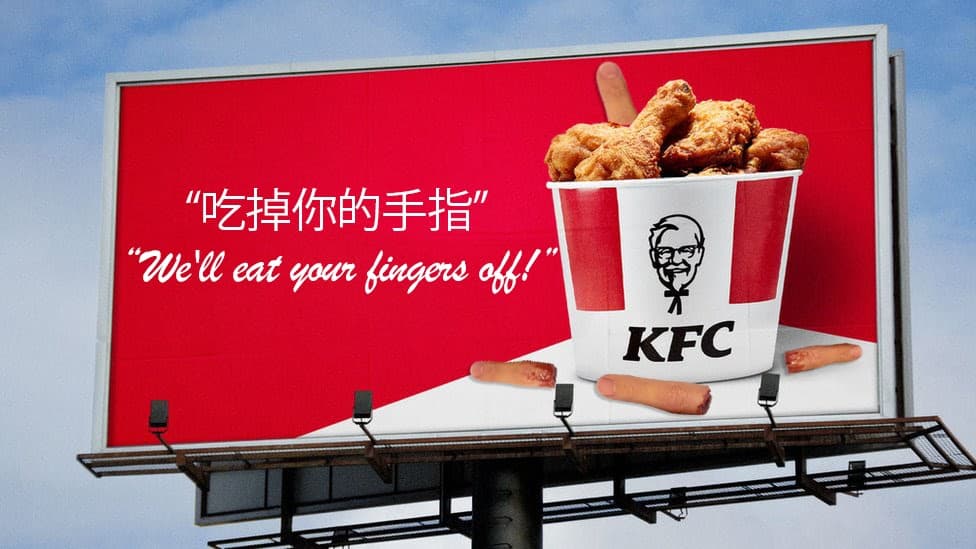In 1987 Colonel Sanders and his secret blend of eleven herbs and spices are on an international mission to conquer China.
Wildly successful in other global markets, all they need to do is translate and localize their marketing materials into Mandarin. The Colonels’ famous rallying cry, ‘It’s Finger-Lickin’ Good!’ should surely do the trick, already synonymous with KFC around the globe. Until now.
Unfortunately, that year, KFC’s communication department did not quite hit the mark with the translation. What should have read ‘KFC – it’s finger-lickin’ good’ became ‘KFC – we’ll eat your fingers off’. No doubt a good deal more threatening than they intended and certainly disconcerting, to say the least!

On the path to taking your business global, marketing localization will play an integral role in adapting your marketing strategies. When it comes to broaching a target market, even mega brands can make a hash of it. So Text United has put together a brief guide to help signpost your marketing localization journey!
The 6 step guide for Marketing Localization:
- Research your target audience
- Review your content
- The Right Tools For The Right Job
- Localizing Landing Pages & Ads
- Do Not Neglect SEO Translation
- Review Your Translation & Localization
#1. Research Your Target Audience
Whether you have defined primary and secondary personas, segmented to the last detail, or simply targeted based on market research, knowing your target audience is a no-brainer for marketers. It is also imperative when translating and localizing content.
As a marketing manager, one of your goals is deciding which market to expand to. And naturally, the language you will need translation for. Then you can begin taking a more in-depth look at the audience you intend to be selling to. Localizing your marketing content accurately and authentically means researching your target audience, potential language variations, and anything culturally significant.
FYI, do not underestimate the power of bad localization. Approaching the German market will differ substantially from how your approach to the French, far beyond the language spoken. Spending time localizing properly now will save you down the line meaning you can dodge all manner of pitfalls. Reduced revenue, product rejection, loss of potential new custom, even legal disputes can all be avoided from this first step.
#2. Review Your Content
Reviewing your content when you release it to your native market isn’t something you would neglect. It’s even more crucial here. Your brand identity should remain consistent across borders, and some of your marketing campaigns may even translate well directly. Nevertheless, adapting your content to align with the target audience research you already completed will make it all the more effective.
Maintaining your brand message while ensuring it is accessible to the market you are going after is the aim of the game. This may come in the shape of UI changes; some nations are more weighted towards mobile connectivity. It could mean altering the words and idioms used or removing some content and images entirely. You cannot afford to be precious about your content if it risks alienating your target market; be malleable!
#3. The Right Marketing Tools For The Right Job
An advanced Translation Management System (TMS) is worth consideration to help manage your translation tasks. Also, removing many potential stumbling blocks in one swoop. A TMS optimizes all facets of the translation process by maximizing the productivity of the team members involved. Simplifying engagement between yourself, Project Managers, Translators, Proofreaders, and In-Country Reviewers enables localization to occur swiftly and accurately.
The suite of tools available in a good TMS is relevant here too. A feature like Translation Memory saves resources as it continually captures translations as translators work on your projects for future use. Once a translation is made and corrected, all the repetitions of that term will be automatically translated too. When considering how keywords and SEO work, Translation Memory becomes a powerful tool to have at your disposal.
Further still, given the specific nature of your sector or industry, something like Terminology Management can certainly make life easier. Most companies will have reams of not only industry-specific words but also brand-specific terms too. Having these terms managed, translated, stored, and shareable means important brand marketing terms are always easy to access.
#4. Localize Your Landing Pages & Ads
So you know the market, or markets, that you’re going to enter. You also know which languages you need your content to be translated and localized into. The who and the how of the translation process, fixed. Now it’s time to get your hands dirty in topics that you are an expert in.
No matter if you are growing organically or mostly through paid, you have landing pages that you are leading your prospects to. Now imagine that you are entering the French market with an English landing page. The chance of getting a sufficient, not saying high, conversion rate is pretty far fetched. You can have the utmost best copy ever that you’ve invested meaningful resources to create. However, what is it worth if your target audience cannot understand it perfectly because it is not their native language?
It is more than recommended to translate AND localize your landing pages. Communicate the value you bring to your prospects in their native language to get those conversions and MQLs you are hoping to reach.
Furthermore, the same goes for your Ads. Your ads should be localized as well, as it will help with your rankings. Now, this brings us to the next step, which is SEO Translation.
#5. Do Not Neglect SEO Translation
Translation and localization can fall short when we forget the importance of translating text that people don’t end up seeing. Prospects in your target market will not suddenly start searching search terms that are not native to them. Making SEO Translation is another key element in your battle for visibility in your new market.
Translating website keywords means search engines like Google, Yahoo, or Bing will be able to find and display your site. These keywords must be carefully translated as well as adapted and optimized according to your target market.
To underline the importance of this task, it usually requires transcreation as opposed to just simple translation. Transcreation is, transferring the meaning of a term to the target language while maintaining its intent, style, tone, and context.
#6. Review Your Translation & Localization
Proofreading your translations multiple times is always good practice. Using an Advanced TMS, as mentioned, above allows you to keep an eye on proceedings as they advance. A robust TMS – e.g. Text United – will also generate a list of translation issues or discrepancies. Our Quality Assurance Check will also produce a report detailing all used or unused terminology proposals for your review.
Whilst on the topic of reviewing; with localization, we really can’t stress the benefits of using an In-Country Reviewer enough. Generally speaking, an ICR will be a native speaker of the target language and a specialist in a given field. Although technically a simple additional step in the translation process, the value gained by utilizing an ICR is immense.
Over To You
There you have it! Six steps to help you firmly on your way to becoming a marketing localization legend. Put the work in at the start of your global push and the returns will be clear and obvious. With one successful international push under your belt, you’ll have the infrastructure in place when you tackle the next!







